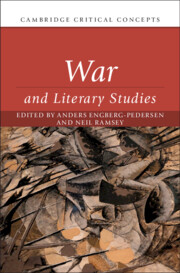Book contents
- War and Literary Studies
- Cambridge Critical Concepts
- War and Literary Studies
- Copyright page
- Contents
- Figures
- Contributors
- Acknowledgments
- Introduction: War, Literature, and the History of Knowledge
- Part I Origins and Theories
- Chapter 1 War and Ancient Athens
- Chapter 2 War and Chinese Culture
- Chapter 3 War and Romantic Thought
- Chapter 4 War and Critical Theory
- Chapter 5 War and French Theory
- Chapter 6 War and Media Studies
- Chapter 7 War and Postcolonial Studies
- Part II Foundational Concepts
- Part III Emerging Concepts
- Index
Chapter 2 - War and Chinese Culture
from Part I - Origins and Theories
Published online by Cambridge University Press: 15 January 2023
- War and Literary Studies
- Cambridge Critical Concepts
- War and Literary Studies
- Copyright page
- Contents
- Figures
- Contributors
- Acknowledgments
- Introduction: War, Literature, and the History of Knowledge
- Part I Origins and Theories
- Chapter 1 War and Ancient Athens
- Chapter 2 War and Chinese Culture
- Chapter 3 War and Romantic Thought
- Chapter 4 War and Critical Theory
- Chapter 5 War and French Theory
- Chapter 6 War and Media Studies
- Chapter 7 War and Postcolonial Studies
- Part II Foundational Concepts
- Part III Emerging Concepts
- Index
Summary
As C. H. Wang observed in 1975, early Chinese representations of war generally perform an “ellipsis of battle” – readily narrating the causes of a war and its ultimate results, but avoiding detailed accounts of the fighting. The reason for this omission lies in the Mencian doctrine that the true ruler of the world must be “one who does not love killing.” Whether or not actual rulers loved killing, they had to be represented as if they went to war only against their will. Twentieth-century conditions changed the meaning of war in China as elsewhere. Warfare was now done by armies massively mobilized among the population; noncombatants found themselves taking an active part or being massacred; phases of civil war pitted Chinese against Chinese. Poets faced a dilemma: to prioritize the obligations of Chinese citizens in a life-or-death struggle for the survival of the nation, or persist in an individualist stance that the struggle put at risk? Examples of modern poets’ thinking through real and imagined actions of warfare show how twentieth-century Chinese literature demolished longstanding taboos and claimed new thematic territories.
- Type
- Chapter
- Information
- War and Literary Studies , pp. 36 - 47Publisher: Cambridge University PressPrint publication year: 2023



